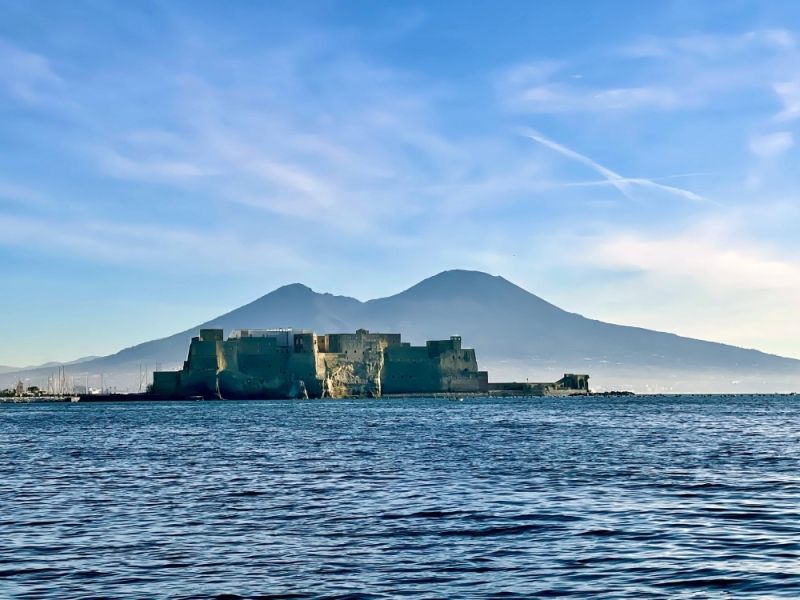The Living History of Naples, a Journey through 3,000 years of History
Naples , founded by the Greeks with the name "Neapolis", is a metropolis of around 1 million inhabitants, capital of culture and privileged stop on the "grand tour" of European nobles since the 18th century and again until the 20th century. A city that thrives on contrasts , with shades of "a thousand colors" (quoted by singer Pino Daniele), with intense aromas and breathtaking landscapes, to be experienced on the surface, but to be known and understood underground. City that never sleeps, which expresses itself during the day, but enchants at night, UNESCO capital of Pizza, founder and homeland of street-food, eternal home of poets such as Virgil and Leopardi, historically very interesting and which could be told even just by citing the nearly hundreds of records held. Visiting it is one of those all-encompassing experiences that, once done, will be kept in your heart for life, a place that never leaves the tourist indifferent, that forces you to love it or hate it, but that will enchant you through the song of the Parthenope Siren ( as he did to Ulysses), you will love him for the rest of your life to the point that you can't wait to return. Naples, according to many and not least the American CNN Tourism section, is one of the places to visit at least once in a lifetime and these are our 10 reasons to do so.
1) Naples, unique in the world, offers its tourists the opportunity to retrace, touch and experience the history of the last 3,000 years.
There are several examples in the world of cities steeped in their history which, monothematically, are a showcase of their past of maximum splendor and in any case of a specific historical arc. But this is not Naples, as it offers its visitors not a historical period, not a period of maximum splendor, but testifies to itself throughout the entire span of its centuries of history, from its foundation to today, a unique opportunity to world where you can relive, layer upon layer, the traces of every People who Conquered, Experienced, Loved it! This is why Naples is a living book, which allows you to study history, understand it, but above all to live it, walking inside it, touching it, seeing it, smelling it. A story that starts from when it was founded in the 9th BC by the Greeks in the area that includes the islet of Megaride (the current Castel dell'Ovo), and then tells us about all the peoples who have come and gone and the events connected to them in centuries. In fact, Neapolis, after the Greeks, was conquered by the Samnites, then it was a Roman city, Duchy of Byzantium in 763 AD, to then pass under the power of the Normans, the Swabians and again the Angevins; in the Renaissance it belonged to the Aragonese, then the Spanish, a brief parenthesis under the French of Napoleon first and then the Austrians, to finally return to the Bourbons of Spain. This makes Naples an incomparable experience, incomparable to others. The multi-cultural city par excellence, which offers tourists vestiges, remains and testimonies of its entire historical journey. In Naples, thinking of taking the Metro, you may come across a Roman port with an almost intact ship from the period, you will walk on streets of Greek stones, you will touch the lava layers of Vesuvius that destroyed Pompeii and Herculaneum, you will visit churches with bell towers that recall the Minarets of Islamic tradition, you will walk underground among Roman cisterns to exit through private homes to discover Roman amphitheatres; you will visit catacombs which house the tomb of the Patron Saint of the City San Gennaro, Royal Palaces, Castles, Galleries with Iron and Glass Domes among the oldest in Europe, you will retrace the era of the Industrial Revolution 1800/1900 seen through Transport (see Museum of the Railways).
There are several examples in the world of cities steeped in their history which, monothematically, are a showcase of their past of maximum splendor and in any case of a specific historical arc. But this is not Naples, as it offers its visitors not a historical period, not a period of maximum splendor, but testifies to itself throughout the entire span of its centuries of history, from its foundation to today, a unique opportunity to world where you can relive, layer upon layer, the traces of every People who Conquered, Experienced, Loved it! This is why Naples is a living book, which allows you to study history, understand it, but above all to live it, walking inside it, touching it, seeing it, smelling it. A story that starts from when it was founded in the 9th BC by the Greeks in the area that includes the islet of Megaride (the current Castel dell'Ovo), and then tells us about all the peoples who have come and gone and the events connected to them in centuries. In fact, Neapolis, after the Greeks, was conquered by the Samnites, then it was a Roman city, Duchy of Byzantium in 763 AD, to then pass under the power of the Normans, the Swabians and again the Angevins; in the Renaissance it belonged to the Aragonese, then the Spanish, a brief parenthesis under the French of Napoleon first and then the Austrians, to finally return to the Bourbons of Spain. This makes Naples an incomparable experience, incomparable to others. The multi-cultural city par excellence, which offers tourists vestiges, remains and testimonies of its entire historical journey. In Naples, thinking of taking the Metro, you may come across a Roman port with an almost intact ship from the period, you will walk on streets of Greek stones, you will touch the lava layers of Vesuvius that destroyed Pompeii and Herculaneum, you will visit churches with bell towers that recall the Minarets of Islamic tradition, you will walk underground among Roman cisterns to exit through private homes to discover Roman amphitheatres; you will visit catacombs which house the tomb of the Patron Saint of the City San Gennaro, Royal Palaces, Castles, Galleries with Iron and Glass Domes among the oldest in Europe, you will retrace the era of the Industrial Revolution 1800/1900 seen through Transport (see Museum of the Railways).
Popular Traditions
2) City of Nativity Scenes.
We are now in the midst of the Christmas atmosphere and the historic centre, in particular San Gregorio Armeno, is teeming with tourists hunting for the beautiful shepherds made by the artisans of the historic workshops that inhabit the historic "Via dei pastori". The nativity scene tradition of San Gregorio Armeno has very ancient origins, dating back to the classical era. Today, among the classic shepherds who "inhabit" the nativity scenes, we can also find the many personalities who, during the year, have stood out for the most diverse reasons. And here you can find Giorgia Meloni rather than Queen Elizabeth but also Damiano dei Maneskin or the three Michelin star Chef, Antonino Cannavacciuolo, Maradona, Beyonce and many other characters.
We are now in the midst of the Christmas atmosphere and the historic centre, in particular San Gregorio Armeno, is teeming with tourists hunting for the beautiful shepherds made by the artisans of the historic workshops that inhabit the historic "Via dei pastori". The nativity scene tradition of San Gregorio Armeno has very ancient origins, dating back to the classical era. Today, among the classic shepherds who "inhabit" the nativity scenes, we can also find the many personalities who, during the year, have stood out for the most diverse reasons. And here you can find Giorgia Meloni rather than Queen Elizabeth but also Damiano dei Maneskin or the three Michelin star Chef, Antonino Cannavacciuolo, Maradona, Beyonce and many other characters.
3) Capital of Records.
Naples is one of the greatest cultural capitals of Europe and the world, over the centuries it has accumulated such a quantity of records, to the point that there are too many to list them all. Just to name one, just think that the entire historic center of Naples (among the largest in the world) has been declared a UNESCO World Heritage Site. You can take a look at our. article in which we list all the records of this fantastic city, by clicking on the link below https://www.metour.it/news/sapevi-che-napoli-e-capitale-di-record-e-primati-e- many-are-still-visible-/
Naples is one of the greatest cultural capitals of Europe and the world, over the centuries it has accumulated such a quantity of records, to the point that there are too many to list them all. Just to name one, just think that the entire historic center of Naples (among the largest in the world) has been declared a UNESCO World Heritage Site. You can take a look at our. article in which we list all the records of this fantastic city, by clicking on the link below https://www.metour.it/news/sapevi-che-napoli-e-capitale-di-record-e-primati-e- many-are-still-visible-/
The Authentic Tastes of Naples
4) Pizza, Street Food and Neapolitan Cuisine.
Surely, pizza is one of the main reasons why tourists choose to come to Naples. Yes, because tasting real Neapolitan pizza, declared a UNESCO Intangible Heritage, is a sensorial experience, which you will not easily forget and every time you return to the city it will be the first thing you will want to eat. Then there are the "cuoppo" fried foods to buy on the fly while walking around the centre. In the "cuoppo" you will find potato croquettes, pasta omelettes, arancini which here we call pall' e ris' (rice balls), the "cuzzettiello" (end part of the loaf of bread) with polettes, fried pizzas and "a" pizzas. wallet". There's no point in beating around the bush, street food was born in Naples. But, in reality, all Neapolitan cuisine, with its countless traditional dishes, manages to satisfy even the most demanding palates. Pasta and potatoes with or without provola, Genovese, parmigiana, ragù, spaghetti with clams and so on and so forth.
5) Neapolitan Coffee and Pastry
Neapolitans like to end their meal with a nice coffee which, like many things, must be done to perfection. Compared to other espresso coffees made by bars throughout Italy, Neapolitan coffee is much stronger, as the beans that compose it have a part of Arabica blend which is much more robust and richer in caffeine. The beans are then roasted at higher temperatures. Having coffee in Naples is a real ritual and meeting a friend is the excuse to enjoy another one. First, the barista will offer you water, strictly sparkling as the bubbles will "clean" your mouth from other flavors, so you can fully enjoy the coffee. The coffee must be boiling hot and the cup in which they will serve it to you will also be very hot, so be careful not to burn yourself. And then when paying, don't forget to leave one "suspended", that is, to pay one more to those who cannot afford it (in Naples, the capital of hospitality, this has always been done). Finally, just to "stay in shape", you can't do without an excellent dessert by choosing between babà or Sfogliatella (curly or shortcrust). If you were to visit Naples during the Christmas period, then, you can taste pastiera, struffoli, mustacciuoli, roccocò... Neapolitan pastry making has a long tradition.
Surely, pizza is one of the main reasons why tourists choose to come to Naples. Yes, because tasting real Neapolitan pizza, declared a UNESCO Intangible Heritage, is a sensorial experience, which you will not easily forget and every time you return to the city it will be the first thing you will want to eat. Then there are the "cuoppo" fried foods to buy on the fly while walking around the centre. In the "cuoppo" you will find potato croquettes, pasta omelettes, arancini which here we call pall' e ris' (rice balls), the "cuzzettiello" (end part of the loaf of bread) with polettes, fried pizzas and "a" pizzas. wallet". There's no point in beating around the bush, street food was born in Naples. But, in reality, all Neapolitan cuisine, with its countless traditional dishes, manages to satisfy even the most demanding palates. Pasta and potatoes with or without provola, Genovese, parmigiana, ragù, spaghetti with clams and so on and so forth.
5) Neapolitan Coffee and Pastry
Neapolitans like to end their meal with a nice coffee which, like many things, must be done to perfection. Compared to other espresso coffees made by bars throughout Italy, Neapolitan coffee is much stronger, as the beans that compose it have a part of Arabica blend which is much more robust and richer in caffeine. The beans are then roasted at higher temperatures. Having coffee in Naples is a real ritual and meeting a friend is the excuse to enjoy another one. First, the barista will offer you water, strictly sparkling as the bubbles will "clean" your mouth from other flavors, so you can fully enjoy the coffee. The coffee must be boiling hot and the cup in which they will serve it to you will also be very hot, so be careful not to burn yourself. And then when paying, don't forget to leave one "suspended", that is, to pay one more to those who cannot afford it (in Naples, the capital of hospitality, this has always been done). Finally, just to "stay in shape", you can't do without an excellent dessert by choosing between babà or Sfogliatella (curly or shortcrust). If you were to visit Naples during the Christmas period, then, you can taste pastiera, struffoli, mustacciuoli, roccocò... Neapolitan pastry making has a long tradition.
6) The Veiled Christ.
Naples is full of museums that house wonderful works of art. One above all, however, prevails over the others. We are talking about the Veiled Christ, the wonderful sculpture created by Giuseppe Sanmartino and kept in the mysterious San Severo Chapel. Antonio Canova was so struck by the magnificence of the work that he declared that he would have given 10 years of his life to have been the one to create the work. The magnificent sculpture is a marble "bed" on which the body of Jesus Christ lies, dead, after being taken down from the cross. At his feet there are the symbols of martyrdom: the crown of thorns and the nails with pincers. Christ is covered by a marble veil and this is the true magnificence of the sculpture. Sanmartino created the shroud with so much skill that it becomes real in the eyes of those who observe the sculpture. The work is so fantastic that over the centuries the legend has been handed down according to which the noble Raimondo di Sangro, who commissioned the work, being an alchemist, managed to carry out an alchemical process, called marbling, thanks to which the veil would have calcified.
Naples is full of museums that house wonderful works of art. One above all, however, prevails over the others. We are talking about the Veiled Christ, the wonderful sculpture created by Giuseppe Sanmartino and kept in the mysterious San Severo Chapel. Antonio Canova was so struck by the magnificence of the work that he declared that he would have given 10 years of his life to have been the one to create the work. The magnificent sculpture is a marble "bed" on which the body of Jesus Christ lies, dead, after being taken down from the cross. At his feet there are the symbols of martyrdom: the crown of thorns and the nails with pincers. Christ is covered by a marble veil and this is the true magnificence of the sculpture. Sanmartino created the shroud with so much skill that it becomes real in the eyes of those who observe the sculpture. The work is so fantastic that over the centuries the legend has been handed down according to which the noble Raimondo di Sangro, who commissioned the work, being an alchemist, managed to carry out an alchemical process, called marbling, thanks to which the veil would have calcified.
The Artistic Wonders
7) The Mystery and the Esoteric.
It is not only the Sansevero Chapel that is hidden by mystery... There are many places in Naples shrouded in mystery, with a certain esoteric quality. The Neapolitans have a great bond with the afterlife, traceable in the devotion they have for the "pezzentelle" souls, that is, the skulls (and capuzzell') of the magical Fontanelle Cemetery. These skulls are adopted with prayers and care in exchange for protection, but also, why not, numbers to play the lottery in the hope of a good win. One of the most famous skulls in Naples is that of Lucia, the so-called "skull with the veil" which is found, however, in the Church of Santa Maria delle Anime del Purgatorio ad Arco (in Via dei Tribunali). It seems that Lucia, in love with a baker, poisoned herself because her parents, as nobles, forbade her to marry him (a story that is said to have inspired Shakespeare for the story of Romeo and Juliet). Young women looking for love are very devoted to Lucia. But one of the most mysterious cults of Naples is certainly the one linked to the blood of San Gennaro, the patron saint of the city who, in particular, "fa'o mirac'l" (miracle) on September 19th of each year. The saint's blood is preserved in a very ancient ampoule inside the Cathedral of Naples and every year, on the day of San Gennaro which falls on September 19th, the blood liquefies. The melting of the blood is seen as a good omen by the Neapolitans as it means that, by melting the blood, San Gennaro will continue to protect the city. If the blood, however, does not dissolve, it means that something bad is about to happen to the city. For example, in 1939 the miracle did not happen and in fact World War II broke out which also brought death and destruction to Naples. A relationship between the Saint and the devotion of the Neapolitans which has been nominated for UNESCO Intangible Heritage of Humanity.
8) The Coast and the Islands.
Many tourists take advantage of being in Naples to then visit Sorrento, Positano, Amalfi but also the islands of Capri, Ischia and Procida. Yes, because the pearls of Campania absolutely deserve to be visited. On our website, by clicking on "Places to See", you will find all the information for these magnificent destinations, unique in the world and worth the trip.
Many tourists take advantage of being in Naples to then visit Sorrento, Positano, Amalfi but also the islands of Capri, Ischia and Procida. Yes, because the pearls of Campania absolutely deserve to be visited. On our website, by clicking on "Places to See", you will find all the information for these magnificent destinations, unique in the world and worth the trip.
9) Vesuvius.
Coming to Naples, you have the possibility of finding yourself just a few kilometers away from wonderful places. One of these is the imposing Vesuvius with its 1,232 meters of height. You can, therefore, climb to the summit and from here look into its crater with a diameter of 450 meters and understand the destructive force that it was capable of unleashing to the point of razing Pompeii and Herculaneum to the ground in 79 BC. C. But once on the Neapolitan Volcano, as well as enjoying an incredible panorama from its summit, you can follow a rich number of nature trails, in fact Vesuvius is a National Park. In particular, you will be able to go horseback riding, eat in excellent farmhouses that offer 0 km products grown in those rich volvanic lands and which produce unique products such as the "piennolo" tomato or the Lacryma Christi wine, this obtained from native grapes already cultivated in the of the Romans.
10) The Views.
When you visit Naples you don't necessarily have to go to museums. Naples is a museum! The simple fact of walking along Via Caracciolo, admiring the Castel dell'Ovo, with Vesuvius as a backdrop trumps any work of art. In Posillipo, there is the stretch with the most beautiful panorama of Naples, from which you will admire the Gulf of Naples with Capri, the Sorrento Peninsula and, in the background, Vesuvius and then the seafront of Naples with the Castel dell'Ovo and the hill with bell towers, Castel Sant'Elmo and San Martino... an unmissable panorama to photograph during the day, but especially at night. Even from the Vomero hill, arriving up to the Certosa di San Martino, you will admire a beautiful panorama, different from that of Posillipo, as from San Martino you can see SpaccaNapoli, the heart of the historic centre. From the Virgiliano Park, however, you can also stop to admire the beautiful panorama overlooking Pozzuoli, the Campi Flegrei, the islands of Ischia and Procida. Then there is the view from Via Manzoni from where you can admire the Maradona Stadium and the Industrial Area of Bagnoli, then there is the view....
When you visit Naples you don't necessarily have to go to museums. Naples is a museum! The simple fact of walking along Via Caracciolo, admiring the Castel dell'Ovo, with Vesuvius as a backdrop trumps any work of art. In Posillipo, there is the stretch with the most beautiful panorama of Naples, from which you will admire the Gulf of Naples with Capri, the Sorrento Peninsula and, in the background, Vesuvius and then the seafront of Naples with the Castel dell'Ovo and the hill with bell towers, Castel Sant'Elmo and San Martino... an unmissable panorama to photograph during the day, but especially at night. Even from the Vomero hill, arriving up to the Certosa di San Martino, you will admire a beautiful panorama, different from that of Posillipo, as from San Martino you can see SpaccaNapoli, the heart of the historic centre. From the Virgiliano Park, however, you can also stop to admire the beautiful panorama overlooking Pozzuoli, the Campi Flegrei, the islands of Ischia and Procida. Then there is the view from Via Manzoni from where you can admire the Maradona Stadium and the Industrial Area of Bagnoli, then there is the view....
In short, there are many reasons for a trip to Naples, beyond the 10 listed here, because we would have to mention the welcome of the Neapolitans, the beautiful architecture of the Spanish Quarter and the healthcare, the relationship between Naples and Maradona, the culture , of the tombs of Virgil and Leopardi, of the Museums... in short, too many (!) to the point that you should travel first and come and have an aperitif on one of the panoramic terraces where you will fall in love with this city in the light of the magnificent colors of the sun setting into the sea.









